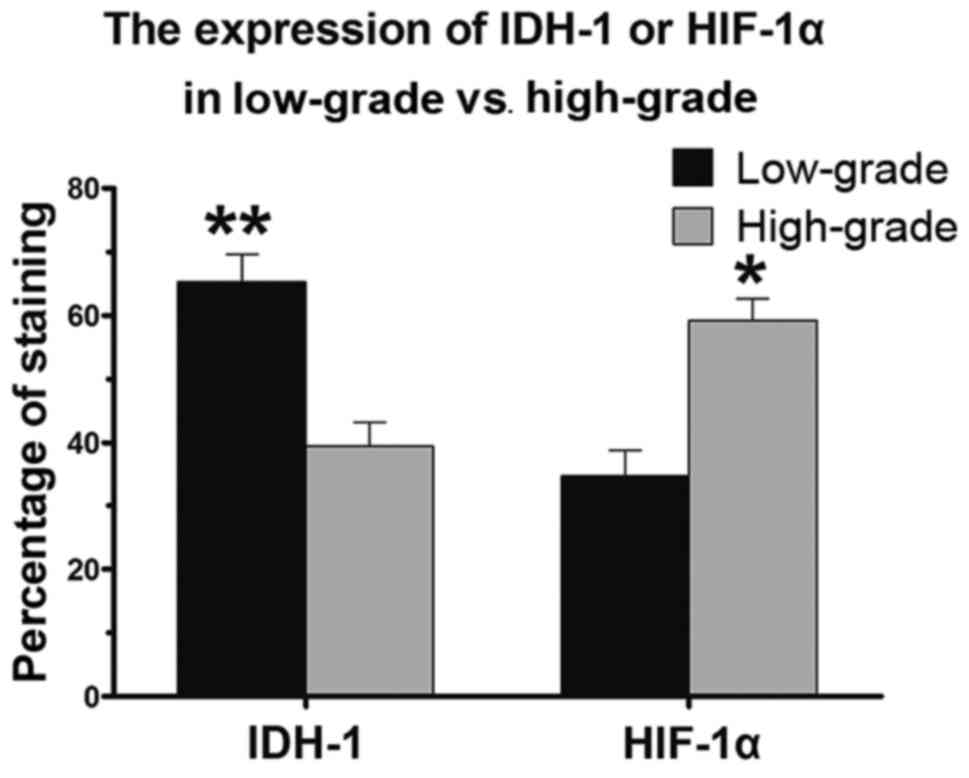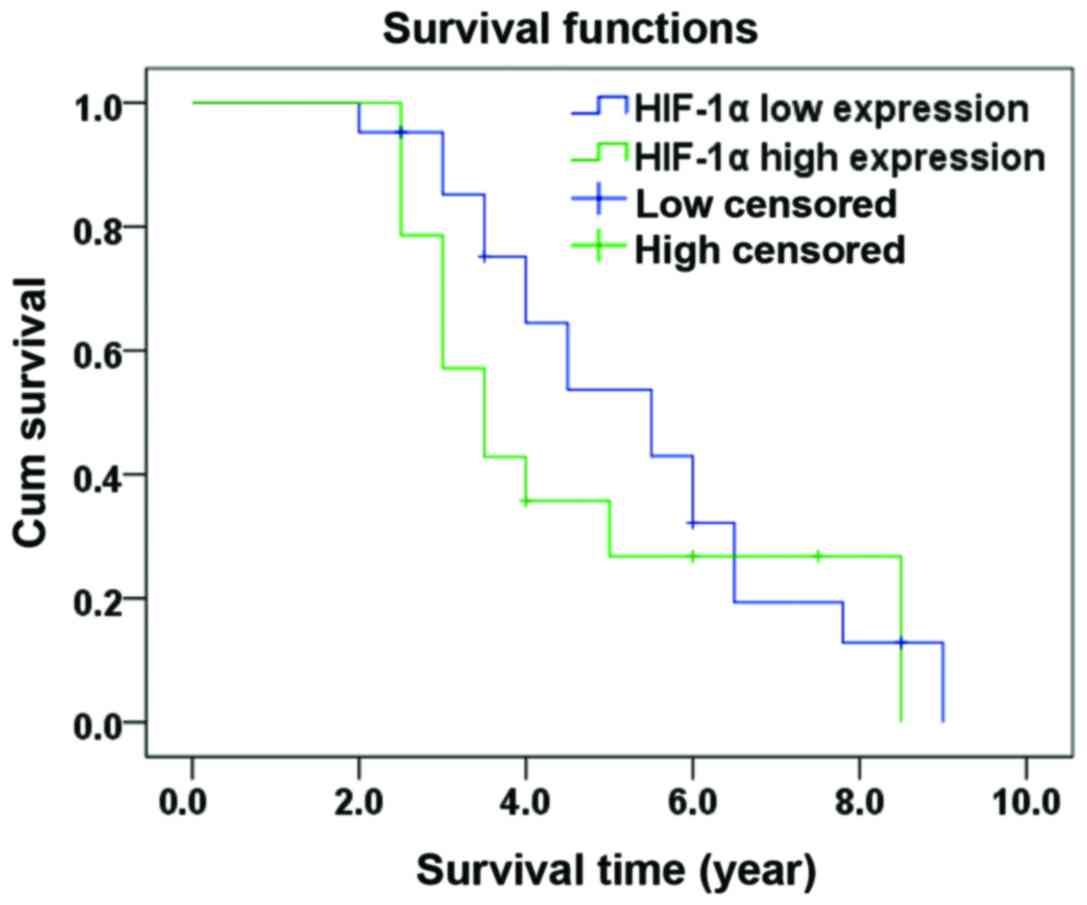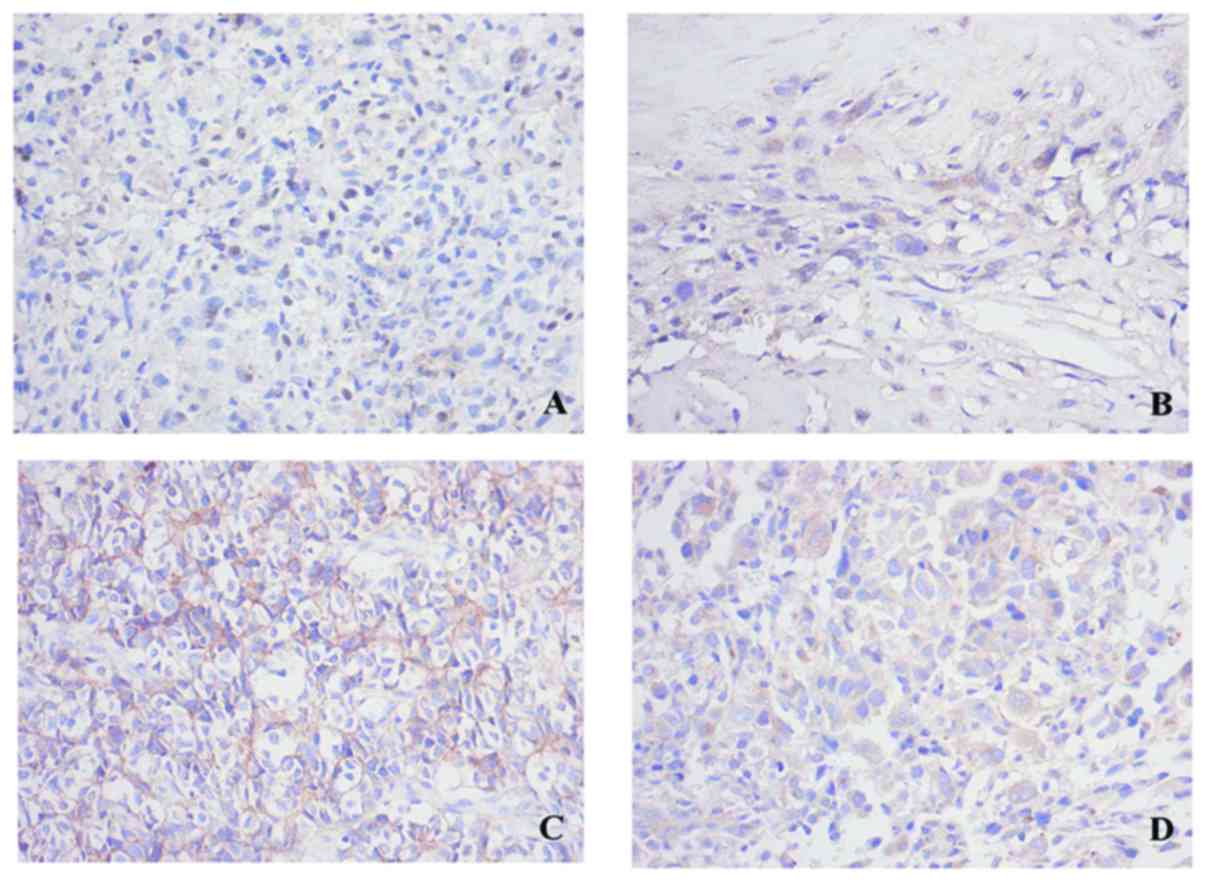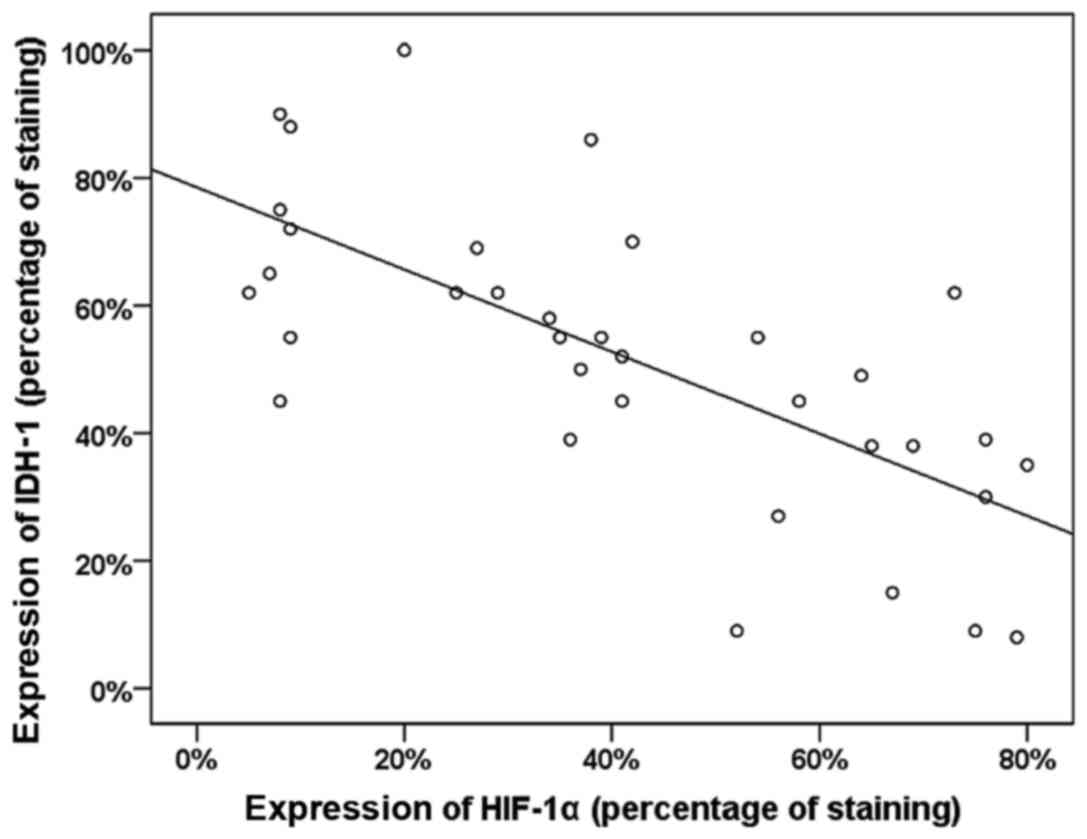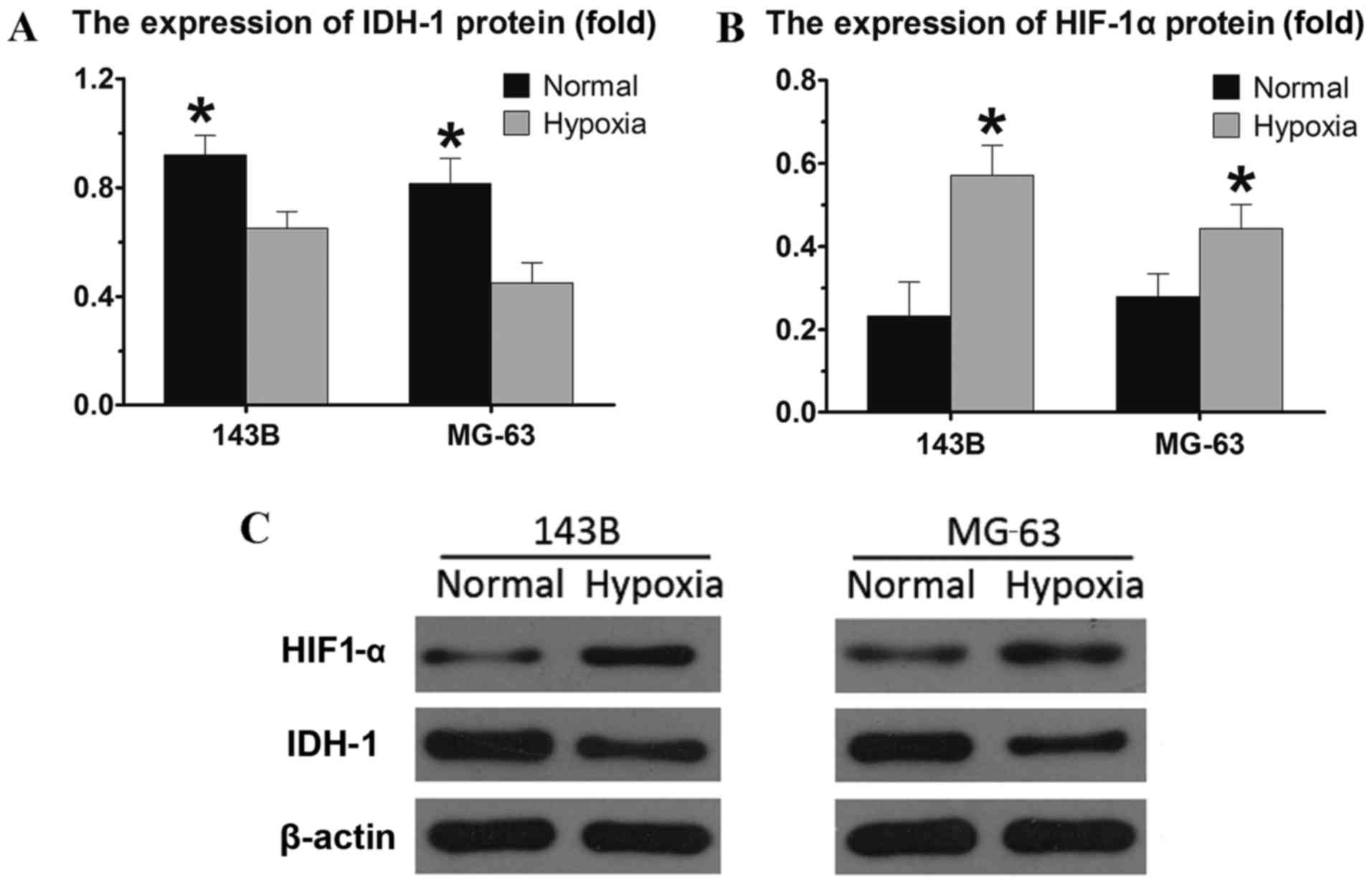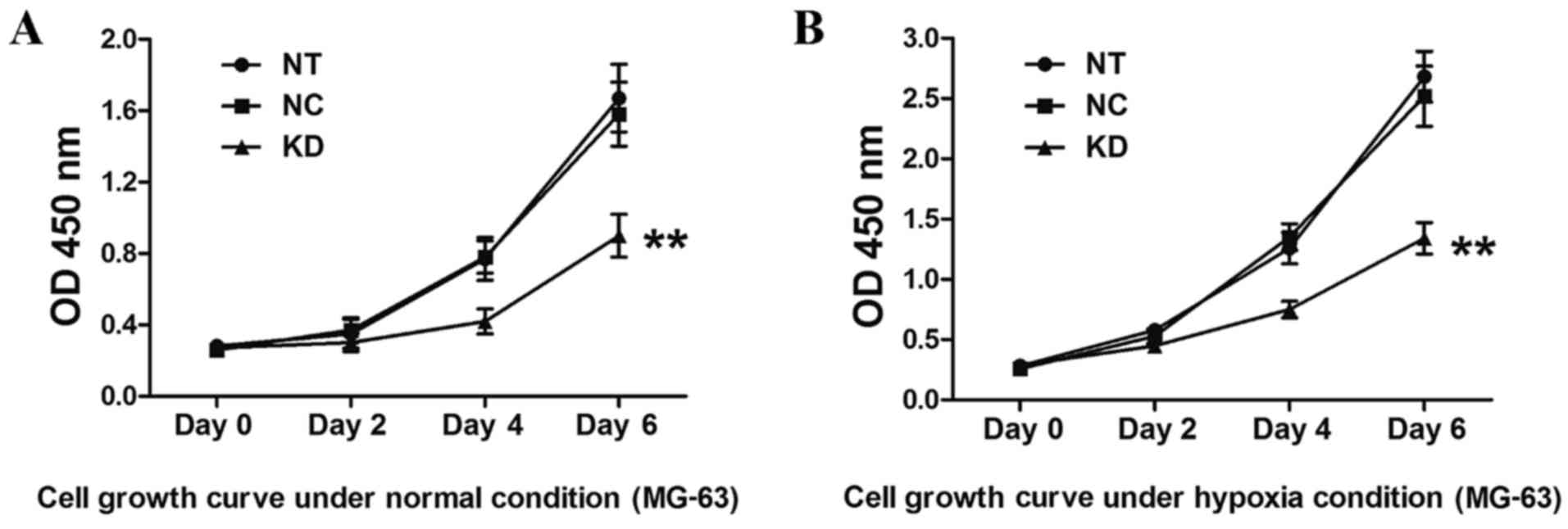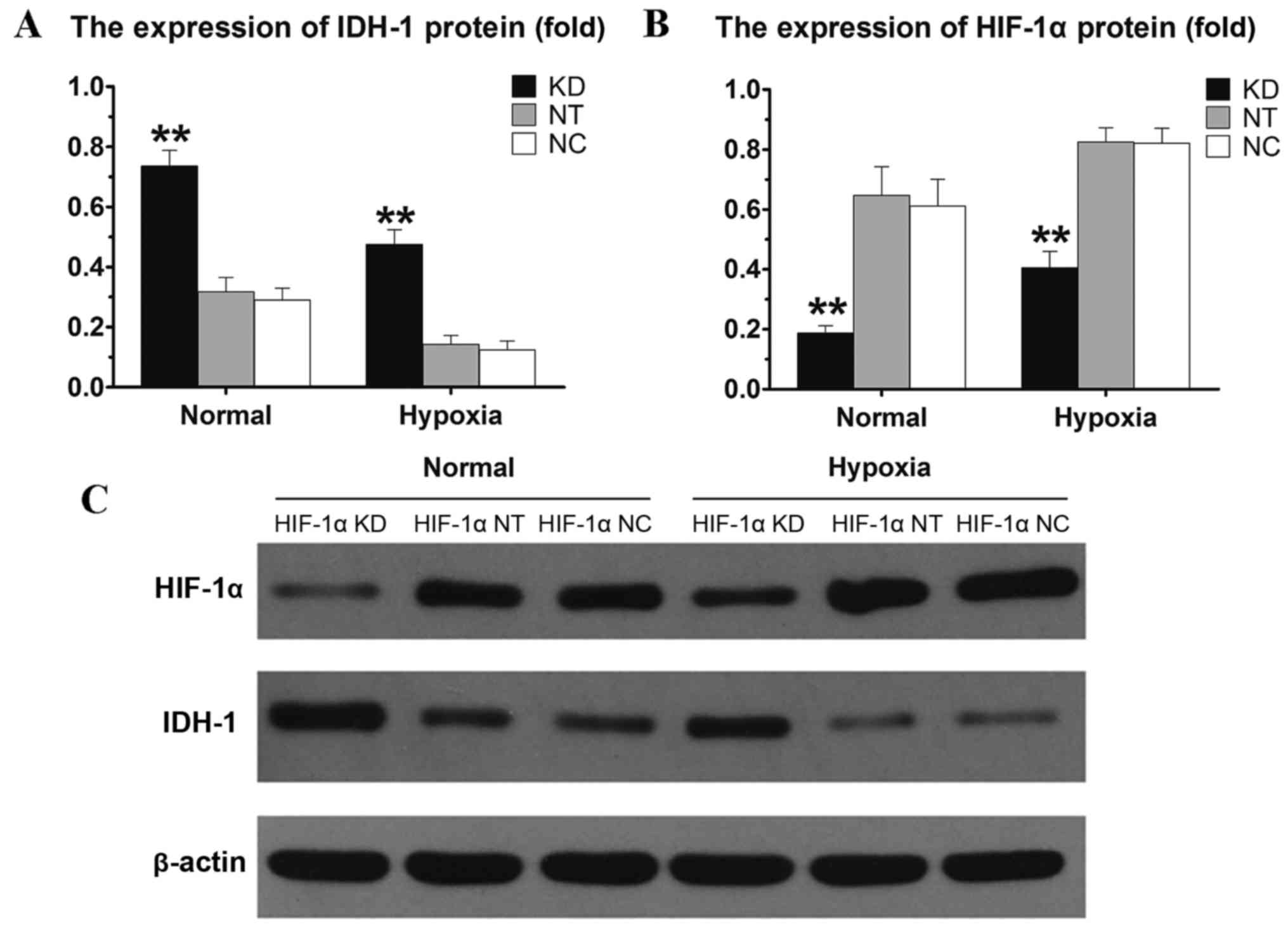Introduction
Osteosarcoma is the most common malignant bone tumor
in children and adolescents. Its 5-year overall survival rate has
increased to 70–80% (1,2) due to the development of effective
diagnostic and treatment strategies for osteosarcoma in recent
years (3). However, the survival
rate has now reached a plateau. One important reason is the lack of
precise targets and related mechanisms.
Numerous solid tumors, including osteosarcoma,
require a hypoxic microenvironment. A hypoxic state aids tumor
growth and metastasis by inducing the release of various cytokines
that promote angiogenesis (4).
Hypoxia-inducible factor-1 (HIF-1) was first discovered by Wang and
Semenza (5) in the study of
hypoxia-induced gene expression. It is composed of two subunits,
HIF-1α and HIF-1β, in which HIF-1α is the main unit and its
expression is regulated by oxygen partial pressure. Hypoxia
contributes to processes critical for cancer progression, such as
resistance to chemotherapy and radiation therapy (6). HIF-1α is overexpressed in many types
of malignant tumors (7–9), and is reported to be a critical and
highly specific factor responding directly to hypoxia (10,11).
HIF-1α is highly expressed in tumors under hypoxic conditions. It
promotes the transcription of downstream target genes to adapt to
the changes in the tumor microenvironment and to enhance the
proliferation and metastasis of tumor cells and their tolerance to
radiotherapy and chemotherapy (12).
Isocitrate dehydrogenase (IDH) is a type of enzyme
family that plays an important role in many types of tumors. These
enzymes are involved in the tricarboxylic acid (TCA) cycle and
produce α-ketoglutarate (α-KG) via the oxidative decarboxylation of
isocitrate (13). There are 5 human
IDH genes (IDH-1 and IDH2 are homologous genes), encoding a total
of 3 different IDH enzymes, in which IDH-1 is located in the
cytoplasm and peroxidase and acts as the main source of
non-mitochondrial NADPH required by multiple metabolic pathways
(14). IDH-1 is regulated by
cholesterol and fatty acid biosynthetic pathways, suggesting that
IDH-1 provides cytosolic NADPH required by these pathways (15). Memon et al (16) found that in bladder cancer, the
IDH-1 protein expression in lowly differentiated cancer cell lines
was significantly lower than that in highly differentiated cancer
cell lines, and the IDH-1 expression level was also significantly
decreased in advanced cancer tissues. The IDH-1 gene may play a
role as a tumor-suppressor gene to maintain the steady state of
cells; thus, the occurrence of malignancies may be greatly
increased after its mutation (17).
In recent years, numerous studies have been
conducted on HIF-1α and IDH-1 expression in osteosarcoma (18–21)
while studies on the correlation of the two have rarely been
reported. The present study was designed to investigate the
expression interaction of the two genes under different conditions
to explore their relationship and to further understand the
mechanism of HIF-1α and IDH-1 in osteosarcoma.
Materials and methods
Tissue specimens and clinical
data
Thirty-five formalin-fixed, paraffin-embedded
osteosarcoma specimens (before the administration of neo-adjuvant
chemotherapy) were collected according to Chinese National Ethical
Guidelines (‘Code for Proper Secondary Use of Human Tissue’,
Chinese Federation of Medical Scientific Societies). All of the
patients exhibited the diagnostic criteria for osteosarcoma as
defined by the World Health Organization classification. Written
informed consent was obtained from each patient before entering the
present study, and all study protocols were approved by the Ethics
Committee for Clinical Research of Wuhan University (Wuhan, China).
The clinical data of IDH-1 were described in our previous study
(22). Osteosarcoma specimens were
graded using Rosen classification (23) (grade 1, tumor necrosis <50%;
grade 2, tumor necrosis 50–90%; grade 3, tumor necrosis >90%;
grade 4, tumor necrosis 100%; grade 1 and 2 are low histological
Rosen grades, and grade 3 and 4 are high histological Rosen
grades). We obtained 4 cases of grade 1, 12 cases of grade 2, 13
cases of grade 3, and 6 cases of grade 4. All of the osteosarcoma
specimens were sliced into 4-µm serial sections followed by
immunohistochemical staining.
Immunohistochemistry and evaluation of
immunohistochemical results
All of the sections were obtained from
formalin-fixed, paraffin-embedded osteosarcoma tissues and baked at
65°C for 2 h. After dewaxing, the sections were washed with
phosphate-buffered saline (PBS) 3 times, and then placed in EDTA
buffer for microwave antigen retrieval, boiled at medium heat and
10 min later, boiled again at low heat. After cooling, the sections
were washed again with PBS 3 times, and then placed in 3% hydrogen
peroxide solution and incubated for 10 min at room temperature in
the dark. Anti-IDH-1 rabbit polyclonal antibody (Protein Tech
Group, Chicago, IL, USA) or anti-HIF-1α rabbit polyclonal antibody
(Abcam, Cambridge, MA, USA) was added to each section to cover the
tissue and kept at 4°C overnight. Then, a goat anti-rabbit
secondary antibody (KPL, Gaithersburg, MD, USA) was added to each
section and incubated at 37°C for 50 min. The sections were washed
with PBS 3 times for 5 min each time. Following the removal of PBS,
50–100 µl fresh DAB solution (Zymed, South San Francisco, CA, USA)
was added to each section. Chromogenic reactions were controlled
with a microscope, and hematoxylin staining was performed. A brown
or tan zone was considered positive staining. The percentage of
positive staining cells in the specimens was used to score the
immunohistochemistry staining results (24,25)
(for each section, two double-blinded pathologists independently
observed each slide, 10 fields were randomly selected, and the mean
positive cell percentage was used as the final result), and the
specific classification was as follows: 0, no positively stained
cells; 1 point, a positive cell percentage (i.e., cell staining
rate) ≤10%; 2 points, a positive cell percentage of 10–25%; 3
points, a positive cell percentage of 26–50%; 4 points, a positive
cell percentage of 51–75%; and 5 points, a positive cell percentage
of >75%. A staining rate of 10% was chosen as the critical value
of the negative and positive protein expression, and a staining
rate >10% was considered positive protein expression and ≤10%
was negative. Zero to 3 points denoted a low expression level (cell
staining rate ≤50%), and 4–5 points represents a high protein
expression level (cell staining rate >50%).
Western blotting
Human osteosarcoma cell lines MG-63 and 143B were
obtained from the American Type Culture Collection (ATCC; Manassas,
VA, USA) through LGC Promochem (Wesel, Germany). Osteosarcoma cells
were exposed to hypoxia (oxygen content of 1%) and normal
conditions (oxygen content of 20%) (26). The cells were thoroughly lysed with
an appropriate amount of RIPA lysis buffer (Aspen, USA), and the
lysate was centrifuged at 4°C at 12,000 rpm for 5 min to collect
the total protein solution. Using a BCA protein assay kit (Aspen),
the protein concentration of the sample was determined. According
to the concentration of each sample, 40 µg of total protein of each
sample was used as a loading sample, in which the appropriate
amount of 5X protein loading buffer was added, and then heated in a
95°C water bath for 5 min and loaded on a gel. After the
electrophoresis was complete, the proteins were transferred to a
polyvinylidene fluoride (PVDF) membrane (Millipore, Billerica, MA,
USA). The transferred membranes were blocked with 5% skim milk in
Tris-buffered saline with 0.05% Tween-20 (TBST) and washed 6 times
in TBST. IDH-1 and HIF-1α proteins were detected by the rabbit
polyclonal antibody for IDH-1 (Protein Tech Group) or HIF-1α
(Abcam). β-actin proteins were recognized by the β-actin-specific
monoclonal mouse IgG (Santa Cruz Biotechnology, Santa Cruz, CA,
USA). Antibodies were diluted according to the manufacturers
instructions, and were incubated overnight at 4°C followed by
incubation with peroxidase-conjugated goat anti-rabbit
immunoglobulin (1:2,000; Santa Cruz Biotechnology) in TBST for 1 h.
Signals were developed using enhanced chemiluminescent reagent
(Pierce Biotechnology, Rockford, IL, USA). β-actin was used as the
internal loading control. The band intensity was analyzed using
Quantity One software (Bio-Rad, Hercules, CA, USA). Relative
expression was calculated as the intensity ratio of target protein
to that of β-actin.
Establishment of stable
HIF-1α-knockdown osteosarcoma cells
To downregulate HIF-1α, a small interfering RNA
sequence inserted into the pLL3.7 shRNA lentivector (Genesil,
Wuhan, China) to reduce HIF-1α expression was
5′-CUGAUGACCAGCAACUUGAdTdT-3′ (sense) and
5′-UCAAGUUGCUGGUCAUCAGdTdT-3′ (antisense) (27). The empty lentivector (Genesil) was
used as a negative control. Non-lentivector infection was used as
an additional control. The lentivector stocks were added to the
osteosarcoma cell line MG-63. The cells were infected with the
lentivector, and the GFP-positive cells were counted before G418
selection, using 800 µg/ml for MG-63. The efficiency of the highest
infection, as determined by directly counting GFP-positive cells
and G418 selection, was obtained at a multiplicity of infection
(MOI) of 50 for MG-63. The frequency of infection rose to 95% for
MG-63 cells. Cells infected with knockdown lentivector (KD) were
called KD cells. Cells without lentivector infection were called NT
cells, and the cells with empty lentivector infection were called
NC cells. After selection, the efficiency of infection was verified
by western blotting.
MTT assay
A total of 3.5×103 cells were seeded in
each test well into a 96-well plate to detect cell growth. The
cells were washed with PBS after cultured for 1–6 days. MTT (5
mg/ml) was then added to each well, and the mixture was incubated
at 37°C for 4 h. The culture medium was then replaced with an equal
volume of dimethyl sulfoxide (DMSO). After shaking the plate at
room temperature for 10 min, the absorbance of each well was
determined at 570 nm using a VersaMax microplate reader (Molecular
Devices, Sunnyvale, CA, USA).
Statistical processing
All of the data were analyzed using SPSS 20.0
statistical software. Numerical variable data with homogeneity of
variance were analyzed by an independent samples t-test, and
non-normal numerical variable data were analyzed using the
Mann-Whitney U test. Categorical variables were analyzed using a
Chi-square or Fisher's exact probability tests while a correlation
test of normal distribution data was analyzed by the Pearson
correlation coefficient method, and that of the non-normal data was
performed using the Spearman correlation coefficient method. The
results with P<0.05 were considered to be statistically
significant and those with P<0.01 were of high statistical
significance.
Results
Relationship between IDH-1 and HIF-1α
protein expression in osteosarcoma and clinicopathological
characteristics
There were no significant differences in HIF-1α
expression levels between groups in regards to sex, age, primary
tumor location and tumor tissue type (P>0.05) (Table I). The IDH-1 expression level in the
low histological Rosen grade group (tumor necrosis, ≤90%) was
significantly higher than that in the high histological Rosen grade
group with a statistically significant difference (P<0.01), and
the expression level and the tissue classification was negatively
correlated (r=−0.427) (Fig. 1). In
contrast, HIF-1α expression in the high histological Rosen grade
group was significantly higher than that in the low histological
Rosen grade group, and was positively correlated with the tissue
classification (P<0.05, r=0.356) (Fig. 1). Our results also showed that the
survival rate was not significantly correlated with the expression
of HIF-1α (P>0.05) (Fig. 2).
 | Table I.Clinical features of the 35
osteosarcoma tumor samples. |
Table I.
Clinical features of the 35
osteosarcoma tumor samples.
|
|
|
| HIF-1α protein |
|
|---|
|
|
|
|
|
|
|---|
| Clinical
features | n (%) | P-value | Low (%) | High (%) | P-value |
|---|
| Total | 35 (100.0) |
| 21 (60.0) | 14 (40.0) |
|
| Age (years) |
| 0.688 |
|
| 0.437 |
| ≤20 | 20 (57.1) |
| 13 (65.0) | 7 (35.0) |
|
|
>20 | 15 (42.9) |
| 8 (53.3) | 7 (46.7) |
|
| Sex |
| 0.225 |
|
| 0.985 |
| Male | 27 (77.1) |
| 16 (59.3) | 11 (40.7) |
|
|
Female | 8 (22.9) |
| 5 (62.5) | 3 (37.5) |
|
| Primary tumor
site |
| 0.146 |
|
| 0.864 |
|
Femur | 14 (40.0) |
| 8 (57.1) | 6 (42.9) |
|
|
Tibia | 10 (28.6) |
| 6 (60.0) | 4 (40.0) |
|
|
Other | 11 (31.4) |
| 7 (63.6) | 4 (36.4) |
|
| Histological
type |
| 0.245 |
|
| 0.364 |
|
Osteoblastic | 15 (42.9) |
| 9 (60.0) | 6 (40.0) |
|
| Small
cell | 3 (8.6) |
| 2 (66.7) | 1 (33.3) |
|
|
Chondroblastic | 3 (8.6) |
| 2 (66.7) | 1 (33.3) |
|
|
Acinous | 1 (2.9) |
| 0 (0.0) | 1 (100.0) |
|
|
Telangiectatic | 2 (5.7) |
| 1 (50.0) | 1 (50.0) |
|
|
Fibroblastic | 8 (22.9) |
| 4 (50.0) | 4 (50.0) |
|
|
Mixed | 3 (8.6) |
| 3 (100.0) | 0 (0.0) |
|
| Histological Rosen
gradea |
| 0.005 |
|
| 0.032 |
| 1 | 4 (11.4) |
| 3 (25.0) | 1 (75.0) |
|
| 2 | 12 (34.3) |
| 10 (83.3) | 2 (16.7) |
|
| 3 | 13 (37.1) |
| 6 (46.2) | 7 (53.8) |
|
| 4 | 6 (17.1) |
| 2 (33.3) | 4 (66.7) |
|
| Low-Rosen grade
(1+2) | 16 (45.7) |
| 13 (81.3) | 3 (18.7) |
|
| High-Rosen grade
(3+4) | 19 (54.3) |
| 8 (42.1) | 11 (57.9) |
|
Expression of IDH-1 and HIF-1α in
osteosarcoma in vivo by immunohistochemistry
We already described that IDH-1 is mainly located in
the cytoplasm (22). In the present
study, we found that HIF-1 protein was also significantly expressed
in the cytoplasm (Fig. 3). The
HIF-1α protein staining rate ranged from 5 to 80%, with a mean
value of 41.46% and an SD of 24.81%, and the corresponding positive
staining score was 1–5, with a mean value of 3.00 and an SD of
1.33. The positive expression rate of HIF-1α protein was 77.1%
(27/35) with a high expression rate of 40% (14/35). The correlation
test between the IDH-1 and the HIF-1α expression levels in 35
samples revealed P<0.01 and r=−0.700 (Fig. 4), indicating that the IDH-1 protein
expression level was negatively correlated with that of the HIF-1α
protein.
Expression of IDH-1 and HIF-1α in
osteosarcoma in vitro under normal and hypoxic conditions by
western blot assay
Our results showed that the expression of IDH-1
protein in 143B and MG-63 cells under normal conditions was higher
than that under hypoxia, and the differences were statistically
significant (P<0.05) (Fig. 5A and
C). In contrast, HIF-1α proteins in 143B and MG-63 cells under
hypoxic conditions were both highly expressed compared to that in
normal conditions (P<0.05) (Fig. 5B
and C).
HIF-1α downregulation decreases the
growth rate of MG-63 cells
HIF-1α downregulation decreased the cell growth rate
of MG-63 KD cells by 0.6- and 0.5-fold on day 6 compared to the
MG-63 NC cells under normal conditions and hypoxic conditions,
respectively (P<0.01) (Fig. 6).
There was no significant difference in the cell growth rate between
MG-63 NT and MG-63 NC cells either under normal conditions or
hypoxic conditions. The MG-63 cell growth rate was suppressed under
hypoxic conditions.
Downregulation of HIF-1α increases the
expression of IDH-1 under normal and hypoxia conditions
Lentivectors were used to downregulate HIF-1α and
the infection efficiency was confirmed by western blotting. HIF-1α
was significantly decreased in the MG-63 KD cells, compared with
the NT and NC cells (P<0.01) both in the hypoxic and normal
group (Fig. 7B and C). There was no
significant difference in HIF-1α protein expression between NT and
NC cells (P>0.05). Meanwhile, IDH-1 protein expression in the
MG-63 KD cells was significantly higher than that noted in the NT
and NC cells either under normal or hypoxic conditions (P<0.01)
(Fig. 7A and C).
Discussion
The expression of IDH-1 and HIF-1α has been reported
in multiple types of tumors (10,16,28).
However, there is still a lack of in-depth study on their
expression in osteosarcoma either in vivo or in
vitro. In the present study, the results showed that the
average HIF-1α protein staining rate in the osteosarcoma tissue
samples of 35 patients was 41.46% and the positive expression rate
was 77.1%. IDH-1 sustains loss-of-function mutations in certain
human tumors, which likewise contribute to tumor growth via
stimulating the HIF-1α pathway and mutationally altering metabolic
enzymes (29,30) while human tumors without IDH-1
mutations have rarely been studied. Through Pearson correlation
coefficient analysis, we first discovered that the expression of
IDH-1 and HIF-1α proteins in osteosarcoma tissues was significantly
negatively correlated with each other, suggesting that there may be
some correlation between them. We also conducted research on the
relationship between HIF-1α protein expression and the
clinicopathological features in osteosarcoma, and found that the
HIF-1α expression levels were not significantly correlated with
sex, age, primary tumor location or tumor tissue type. IDH-1
protein expression in the low histological Rosen grade group was
significantly higher than that in the high histological Rosen grade
group while the HIF-1α expression level showed opposite trends.
The IDH-1 protein is localized in the cytoplasm and
peroxisomes and plays an important role in glucose and lipid
metabolism, antioxidative damage against ROS, and radiation injury
(31). IDH-1 expression in the
osteosarcoma tissue can inhibit the proliferation and metastasis of
osteosarcoma (18). Yang et
al (32) found that the
elevated IDH-1 converted hypoxia-induced melanoma cell invasion and
metastasis to apoptosis, following downregulation of HIF-1α.
However, whether HIF-1α expression affects IDH-1 remains unknown.
We performed a western blot assay to detect IDH-1 and HIF-1α
proteins in 143B and MG-63 cells under hypoxic and normal
conditions. We observed that under normal conditions, HIF-1α bands
were almost invisible in the 143B cells and weakly expressed in the
MG-63 cells while IDH-1 protein was highly expressed in both cell
lines, which suggested a negative correlation between the
expression of IDH-1 and HIF-1α in vitro, in accordance with
our previous in vivo results by immunohistochemistry.
Notably, HIF-1α expression in both osteosarcoma cell lines was
significantly increased under hypoxic conditions, and the
expression of IDH-1 was decreased. HIF-1α activates the
transcription of genes whose protein products function either to
increase O2 delivery or to provide metabolic adaptation
under conditions of hypoxia, further inducing the proliferation and
metastasis of tumor cells (33).
The IDH-1-dependent pathway is active in most cell lines under
normal culture conditions (34) but
is inhibited under hypoxia possibly due to the overexpression of
HIF-1α to some extent.
HIF-1α was found to enhance the proliferation and
metastasis of tumor cells under hypoxia by promoting the
transcription of hypoxia adaptation genes (8,35).
Qian et al (36) found that
knockdown of HIF-1α inhibited cell proliferation and invasion of
lung cancer cells. In a further experiment, we first downregulated
the expression of HIF-1α in MG-63 cells via lentiviral
vector-mediated RNA interference. The western blot assay showed
that downregulation of HIF-1α promoted the expression of IDH-1
protein in osteosarcoma cells under either hypoxic or normal
conditions. The results strongly supported our previous observation
from osteosarcoma patients and cells. Suppression of HIF-1α also
decreased the proliferation of osteosarcoma cells as shown via MTT
assay. Our previous study showed that IDH-1 downregulation
exacerbated osteosarcoma cell proliferation (18). We, therefore, conclude that HIF-1α
may reduce the expression of IDH-1 protein and consequently enhance
the incidence of osteosarcoma. In addition, we found that cell
proliferation may be promoted under conditions of hypoxic stress.
This suggests that overexpression of HIF-1α under hypoxia increases
the transcription of downstream genes, which contributes to cancer
cell proliferation (37,38).
To further investigate the relationship of IDH-1 and
HIF-1α expression with the survival of patients with osteosarcoma,
we performed a survival correlation analysis on 35 patients with
osteosarcoma, and the results showed that the survival of patients
with osteosarcoma was not significantly correlated with the
expression of HIF-1α. From the survival curve, however, we found
that the 2- to 6-year survival of patients in the HIF-1α
low-expressing group was higher than that in the HIF-1α
high-expressing group. Therefore, we considered that the expression
of HIF-1α was correlated with the survival of patients with
osteosarcoma to some extent, while no significant results were
shown due to the limitation of the number of cases and the
influence of cases lost to follow-up.
In summary, the present study highlights that HIF-1α
inhibits IDH-1 expression in osteosarcoma in vitro and in
vivo, which further clarifies the role of HIF-1α in
osteosarcoma pathogenesis.
Acknowledgements
We thank Weidong Xiao, Baiwen Qi, Shengxiang Tao and
Zhenyu Pan for their technical assistance. The present study was
supported by the Hubei Province's Outstanding Medical Academic
Leader Program, the Wuhan's Huanghe Talent Program and National
Natural Science Foundation - Outstanding Youth Foundation of China
(no. 81501535).
References
|
1
|
Anderson ME: Update on survival in
osteosarcoma. Orthop Clin North Am. 47:283–292. 2016. View Article : Google Scholar : PubMed/NCBI
|
|
2
|
Duchman KR, Gao Y and Miller BJ:
Prognostic factors for survival in patients with high-grade
osteosarcoma using the Surveillance, Epidemiology, and End Results
(SEER) Program database. Cancer Epidemiol. 39:593–599. 2015.
View Article : Google Scholar : PubMed/NCBI
|
|
3
|
Rosen G: Preoperative (neoadjuvant)
chemotherapy for osteogenic sarcoma: A ten year experience.
Orthopedics. 8:659–664. 1985.PubMed/NCBI
|
|
4
|
Lendahl U, Lee KL, Yang H and Poellinger
L: Generating specificity and diversity in the transcriptional
response to hypoxia. Nat Rev Genet. 10:821–832. 2009. View Article : Google Scholar : PubMed/NCBI
|
|
5
|
Wang GL and Semenza GL: Characterization
of hypoxia-inducible factor 1 and regulation of DNA binding
activity by hypoxia. J Biol Chem. 268:21513–21518. 1993.PubMed/NCBI
|
|
6
|
Parks SK, Chiche J and Pouysségur J:
Disrupting proton dynamics and energy metabolism for cancer
therapy. Nat Rev Cancer. 13:611–623. 2013. View Article : Google Scholar : PubMed/NCBI
|
|
7
|
Li N, Li Y, Li Z, Huang C, Yang Y, Lang M,
Cao J, Jiang W, Xu Y, Dong J, et al: Hypoxia inducible factor 1
(HIF-1) recruits macrophage to activate pancreatic stellate cells
in pancreatic ductal adenocarcinoma. Int J Mol Sci. 17:172016.
|
|
8
|
Mouriaux F, Sanschagrin F, Diorio C,
Landreville S, Comoz F, Petit E, Bernaudin M, Rousseau AP, Bergeron
D and Morcos M: Increased HIF-1α expression correlates with cell
proliferation and vascular markers CD31 and VEGF-A in uveal
melanoma. Invest Ophthalmol Vis Sci. 55:1277–1283. 2014. View Article : Google Scholar : PubMed/NCBI
|
|
9
|
Guo M, Cai C, Zhao G, Qiu X, Zhao H, Ma Q,
Tian L, Li X, Hu Y, Liao B, et al: Hypoxia promotes migration and
induces CXCR4 expression via HIF-1α activation in human
osteosarcoma. PLoS One. 9:e905182014. View Article : Google Scholar : PubMed/NCBI
|
|
10
|
Zhan H, Liang H, Liu X, Deng J, Wang B and
Hao X: Expression of Rac1, HIF-1α, and VEGF in gastric carcinoma:
Correlation with angiogenesis and prognosis. Onkologie. 36:102–107.
2013. View Article : Google Scholar : PubMed/NCBI
|
|
11
|
Marton I, Knezevic F, Ramic S, Milosevic M
and Tomas D: Immunohistochemical expression and prognostic
significance of HIF-1α and VEGF-C in neuroendocrine breast cancer.
Anticancer Res. 32:5227–5232. 2012.PubMed/NCBI
|
|
12
|
Kaelin WG Jr: How oxygen makes its
presence felt. Genes Dev. 16:1441–1445. 2002. View Article : Google Scholar : PubMed/NCBI
|
|
13
|
Nekrutenko A, Hillis DM, Patton JC,
Bradley RD and Baker RJ: Cytosolic isocitrate dehydrogenase in
humans, mice, and voles and phylogenetic analysis of the enzyme
family. Mol Biol Evol. 15:1674–1684. 1998. View Article : Google Scholar : PubMed/NCBI
|
|
14
|
Boisselier B, Gállego Pérez-Larraya J,
Rossetto M, Labussière M, Ciccarino P, Marie Y, Delattre JY and
Sanson M: Detection of IDH1 mutation in the plasma of patients with
glioma. Neurology. 79:1693–1698. 2012. View Article : Google Scholar : PubMed/NCBI
|
|
15
|
Shechter I, Dai P, Huo L and Guan G: IDH1
gene transcription is sterol regulated and activated by SREBP-1a
and SREBP-2 in human hepatoma HepG2 cells: Evidence that IDH1 may
regulate lipogenesis in hepatic cells. J Lipid Res. 44:2169–2180.
2003. View Article : Google Scholar : PubMed/NCBI
|
|
16
|
Memon AA, Chang JW, Oh BR and Yoo YJ:
Identification of differentially expressed proteins during human
urinary bladder cancer progression. Cancer Detect Prev. 29:249–255.
2005. View Article : Google Scholar : PubMed/NCBI
|
|
17
|
Zhao S, Lin Y, Xu W, Jiang W, Zha Z, Wang
P, Yu W, Li Z, Gong L, Peng Y, et al: Glioma-derived mutations in
IDH1 dominantly inhibit IDH1 catalytic activity and induce
HIF-1alpha. Science. 324:261–265. 2009. View Article : Google Scholar : PubMed/NCBI
|
|
18
|
Hu X, Liu Y, Qin C, Pan Z, Luo J, Yu A and
Cheng Z: Up-regulated isocitrate dehydrogenase 1 suppresses
proliferation, migration and invasion in osteosarcoma: In vitro and
in vivo. Cancer Lett. 346:114–121. 2014. View Article : Google Scholar : PubMed/NCBI
|
|
19
|
Lv F, Du R, Shang W, Suo S, Yu D and Zhang
J: HIF-1α silencing inhibits the growth of osteosarcoma cells by
inducing apoptosis. Ann Clin Lab Sci. 46:140–146. 2016.PubMed/NCBI
|
|
20
|
Roncuzzi L, Pancotti F and Baldini N:
Involvement of HIF-1α activation in the doxorubicin resistance of
human osteosarcoma cells. Oncol Rep. 32:389–394. 2014.PubMed/NCBI
|
|
21
|
Zhang B, Guo W, Yu L, Wang F, Xu Y, Liu Y
and Huang C: Cobalt chloride inhibits tumor formation in
osteosarcoma cells through upregulation of HIF-1α. Oncol Lett.
5:911–916. 2013.PubMed/NCBI
|
|
22
|
Hu X, Yu AX, Qi BW, Fu T, Wu G, Zhou M,
Luo J and Xu JH: The expression and significance of IDH1 and p53 in
osteosarcoma. J Exp Clin Cancer Res. 29:432010. View Article : Google Scholar : PubMed/NCBI
|
|
23
|
Usnarska-Zubkiewicz L, Mazur G, Wróbel T,
Poreba M and Kuliczkowski K: Expression of serum vascular
endothelial growth factor correlates with clinical outcome in
multiple myeloma. Pol Arch Med Wewn. 110:719–724. 2003.(In Polish).
PubMed/NCBI
|
|
24
|
Wu L, Peng CW, Hou JX, Zhang YH, Chen C,
Chen LD and Li Y: Coronin-1C is a novel biomarker for
hepatocellular carcinoma invasive progression identified by
proteomics analysis and clinical validation. J Exp Clin Cancer Res.
29:172010. View Article : Google Scholar : PubMed/NCBI
|
|
25
|
Podar K, Tai YT, Davies FE, Lentzsch S,
Sattler M, Hideshima T, Lin BK, Gupta D, Shima Y, Chauhan D, et al:
Vascular endothelial growth factor triggers signaling cascades
mediating multiple myeloma cell growth and migration. Blood.
98:428–435. 2001. View Article : Google Scholar : PubMed/NCBI
|
|
26
|
Oda S, Oda T, Nishi K, Takabuchi S,
Wakamatsu T, Tanaka T, Adachi T, Fukuda K, Semenza GL and Hirota K:
Macrophage migration inhibitory factor activates hypoxia-inducible
factor in a p53-dependent manner. PLoS One. 3:e22152008. View Article : Google Scholar : PubMed/NCBI
|
|
27
|
Neal CS, Michael MZ, Rawlings LH, Van der
Hoek MB and Gleadle JM: The VHL-dependent regulation of microRNAs
in renal cancer. BMC Med. 8:642010. View Article : Google Scholar : PubMed/NCBI
|
|
28
|
Amary MF, Bacsi K, Maggiani F, Damato S,
Halai D, Berisha F, Pollock R, ODonnell P, Grigoriadis A, Diss T,
et al: IDH1IDH2 mutations are frequent events in central
chondrosarcoma and central and periosteal chondromas but not in
other mesenchymal tumours. J Pathol. 224:334–343. 2011. View Article : Google Scholar : PubMed/NCBI
|
|
29
|
MacKenzie ED, Selak MA, Tennant DA, Payne
LJ, Crosby S, Frederiksen CM, Watson DG and Gottlieb E:
Cell-permeating alpha-ketoglutarate derivatives alleviate
pseudohypoxia in succinate dehydrogenase-deficient cells. Mol Cell
Biol. 27:3282–3289. 2007. View Article : Google Scholar : PubMed/NCBI
|
|
30
|
Ingebretsen OC: Mechanism of the
inhibitory effect of glyoxylate plus oxaloacetate and oxalomalate
on the NADP-specific isocitrate dehydrogenase. Biochim Biophys
Acta. 452:302–309. 1976. View Article : Google Scholar : PubMed/NCBI
|
|
31
|
Krell D, Mulholland P, Frampton AE, Krell
J, Stebbing J and Bardella C: IDH mutations in tumorigenesis and
their potential role as novel therapeutic targets. Future Oncol.
9:1923–1935. 2013. View Article : Google Scholar : PubMed/NCBI
|
|
32
|
Yang X, Du T, Wang X, Zhang Y, Hu W, Du X,
Miao L and Han C: IDH1, a CHOP and C/EBPβ-responsive gene under ER
stress, sensitizes human melanoma cells to hypoxia-induced
apoptosis. Cancer Lett. 365:201–210. 2015. View Article : Google Scholar : PubMed/NCBI
|
|
33
|
Semenza GL: Expression of
hypoxia-inducible factor 1: Mechanisms and consequences. Biochem
Pharmacol. 59:47–53. 2000. View Article : Google Scholar : PubMed/NCBI
|
|
34
|
Metallo CM, Gameiro PA, Bell EL, Mattaini
KR, Yang J, Hiller K, Jewell CM, Johnson ZR, Irvine DJ, Guarente L,
et al: Reductive glutamine metabolism by IDH1 mediates lipogenesis
under hypoxia. Nature. 481:380–384. 2011.PubMed/NCBI
|
|
35
|
Jang BC: The fruit juice of Morinda
citrifolia (noni) downregulates HIF-1α protein expression through
inhibition of PKB, ERK-1/2, JNK-1 and S6 in manganese-stimulated
A549 human lung cancer cells. Int J Mol Med. 29:499–504.
2012.PubMed/NCBI
|
|
36
|
Qian J, Bai H, Gao Z, Dong YU, Pei J, Ma M
and Han B: Downregulation of HIF-1α inhibits the proliferation and
invasion of non-small cell lung cancer NCI-H157 cells. Oncol Lett.
11:1738–1744. 2016.PubMed/NCBI
|
|
37
|
Akakura N, Kobayashi M, Horiuchi I, Suzuki
A, Wang J, Chen J, Niizeki H, Kawamura Ki, Hosokawa M and Asaka M:
Constitutive expression of hypoxia-inducible factor-1alpha renders
pancreatic cancer cells resistant to apoptosis induced by hypoxia
and nutrient deprivation. Cancer Res. 61:6548–6554. 2001.PubMed/NCBI
|
|
38
|
Krishnamachary B, Berg-Dixon S, Kelly B,
Agani F, Feldser D, Ferreira G, Iyer N, LaRusch J, Pak B, Taghavi
P, et al: Regulation of colon carcinoma cell invasion by
hypoxia-inducible factor 1. Cancer Res. 63:1138–1143.
2003.PubMed/NCBI
|















